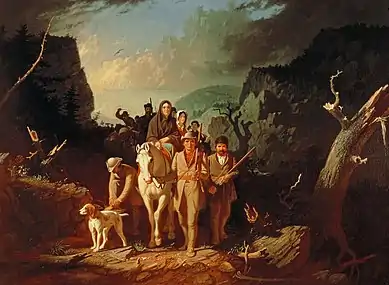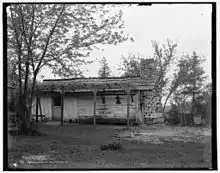Rebecca Boone
Rebecca Ann Bryan Boone (January 9, 1739 – March 18, 1813) was an American pioneer and the wife of famed frontiersman Daniel Boone. No contemporary portrait of her exists, but people who knew her said that when she met her future husband she was nearly as tall as he and very attractive with black hair and dark eyes.[1]
Rebecca Boone | |
|---|---|
| Born | Rebecca Ann Bryan January 9, 1739 |
| Died | March 18, 1813 (aged 74) |
| Resting place | Frankfort Cemetery, Frankfort, Kentucky |
| Spouse(s) | |
| Children |
|
| Parents |
|
Early life
She was born near Winchester, Virginia. Her father was Joseph Bryan, Sr. but there is no clear documentation as to her birth mother. Some say her mother, Hester Hampton, died in childbirth, and that Alice (or Aylee) Linville, Bryan's second wife, raised her.
North Carolina
When she was ten, Rebecca moved with her Quaker grandparents Morgan and Martha (Strode) Bryan, to the Yadkin River valley in the backwoods of North Carolina. Meanwhile, the young Daniel Boone's family settled near the Bryans in North Carolina. Rebecca and Daniel began their courtship in 1753 and married three years later.
Rebecca married Daniel Boone in a triple wedding on August 14, 1756,[2] in Yadkin River, North Carolina at the age of 17. She took in her new husband's two young orphan nephews, Jesse and Jonathan who lived with them in North Carolina until the family left for Kentucky in 1773.
Like her mother and mother-in-law before her, Rebecca had many children born two or three years apart. Over twenty-five years time, she delivered six sons and four daughters of her own:[3]
- 3 May 1757 - James (died 10 October 1773, Clinch Mountains, VA)
- 25 January 1759 - Israel (died 19 August 1782, Blue Licks, KY)
- 2 November 1760 - Susannah (died 19 October 1800)
- 4 October 1762 - Jemima (died 30 August 1829, Montgomery County, MO)
- 23 March 1766 - Levina (died 6 April 1802, Clark County, KY)
- 26 May 1768 - Rebecca (died 14 July 1805, Clark County, KY)
- 23 December 1769 - Daniel Morgan (died 13 July 1839, Jackson County, MO)
- 23 May 1773 - Jesse Bryan (died 22 December 1820)
- 20 June 1775 - William Bryan (died 1775)
- 3 February 1781 - Nathaniel or Nathan (died 16 October 1856, Greene County, MO)
Because her children married young and also had many children, she often took care of grandchildren along with her own babies. When in her early forties, considered an old woman at the time, she adopted the six children of her widowed brother.[1]:47 Without formal education, Rebecca was reputed to be an experienced community midwife, the family doctor, leather tanner, sharpshooter and linen-maker – resourceful and independent in the isolated areas she and her large, combined family often found themselves.

In 1852 George Caleb Bingham painted an epic portrait of Boone escorting settlers through the Cumberland Gap. Using Biblical and classical imagery to justify and heroicize westward expansion, Bingham portrayed Rebecca Boone in the pose of a Madonna, a popular domestic ideal of the time, and she is completed in interpretive ways with a faithful hunting dog and her husband leading a noble charger. She represented all pioneer women who by the mid-nineteenth century were idealized and celebrated. Rebecca's life was difficult as a frontierwoman. She moved many times during her lifetime. Before the birth of her first child, the Boones had moved to a small farm and built a one-story log house on a stream called Sugartree near the extensive Bryan family, near current day Farmington, North Carolina. They stayed in this home for nearly ten years, which was the longest they ever stayed in one place. She created homes in North Carolina, Virginia, Kentucky, and finally Missouri where she spent the last fourteen years of her life.[4]

She often ran her household on her own while her husband was on long hunts and surveying trips. The Cherokee War separated Rebecca and Daniel for nearly four years, and family lore holds that her daughter Jemima was conceived during Daniel's absence, due to her eventual presumption of Daniel's death during that time.[1]
Robert Morgan's biography of Boone says that according to legend, Daniel Boone was away for two years, and during that time Rebecca had a daughter Jemima. Historian Lyman Draper said Rebecca, believing Boone was dead, had a relationship with his brother Edward "Ned" Boone, and her husband accepted the daughter as if she were his.[5][6]
Kentucky
In 1775 Daniel Boone brought his family to the Kentucky River where on behalf of the Transylvania Company he and Richard Henderson laid out Fort Boonesborough. Rebecca left Kentucky in May 1778 under a cloud of rumors that her husband, a captive of the Shawnee, had turned Tory. She returned to her parents' settlement in North Carolina with five of her children, leaving behind Jemima who by then was married to Flanders Callaway.
Daniel Boone came back to his family in North Carolina and finally convinced his wife to leave again for Kentucky - this time with nearly 100 of their kin and joined by the family of Abraham Lincoln (the president's grandfather). In September 1779, this emigration was the largest to date through the Cumberland Gap. By late October 1779, they reached Fort Boonesborough but conditions were so bad that they left on Christmas Day, during what Kentuckians later called the "Hard Winter," to found a new settlement, Boone's Station, with 15-20 families on Boone's Creek about six miles north-west (near what is now Athens, Kentucky). By spring Rebecca and her husband moved to a cabin several miles southwest on Marble Creek. In summer of 1780 at 40 years of age she became pregnant with 10th child (Nathan, born the following March). She lived in a double cabin with five of her children still living at home, the six children of her widowed uncle James Bryan, as well as her daughter Susy with her husband Will Hays with 2-3 children of their own: a household of 19-20 people.
She and her family moved in 1783 where for the next few years she helped Daniel create a landing site at the mouth of Limestone Creek for flatboats coming down the Ohio River from Fort Pitt (Simon Kenton's village was just a few miles inland). Daniel laid out the road to Lexington (soon to be known as the Maysville Road) starting in early 1783. They lived in a cabin built out of an old boat (on what is now Front Street in Maysville, Kentucky). Rebecca, now 46 years old, ran the tavern kitchen and oversaw the seven slaves they owned. By 1786 the town incorporated as Maysville.
Virginia
In 1787 Daniel was elected to legislature as Bourbon County representative, and he moved to Richmond, Virginia with Rebecca and Nathan, leaving the tavern in the hands of their daughter Rebecca and husband Philip Goe.
After Daniel's failed attempts at land speculation and ginseng exports, they moved in 1788 to Charleston (now in West Virginia) in the Kanawha Valley. They settled on the south side of the river almost opposite the mouth of Campbell's Creek in a log house similar to what he had built in Kentucky: two rooms with a "dogtrot" passage between the rooms and a long porch in front.[7]
Missouri
In 1799, Daniel and Rebecca followed Nathan to Spain's Alta Luisiana (Upper Louisiana, now Missouri, about 45 miles west of St. Louis) in the Femme Osage valley. Daniel acquired 850 acres and was appointed Commandant and Syndic, district magistrate by the Spanish government. In 1803 with the Louisiana Purchase, they lost the rights to their lands but with the direct intercession of Congress in 1814 some parts of his acreage were restored.
Death
After a brief illness, Rebecca Boone died at the age of 74 on March 18, 1813, at her daughter Jemima Boone Callaway's home near the village of Charette (near present-day Marthasville, Missouri). She was buried at the Old Bryan Farm Cemetery nearby, overlooking the Missouri River. She and her husband's remains were reinterred and buried again in Frankfort Cemetery in Frankfort, Kentucky in 1845.
Honors
In 1862 a monument was placed over her and her husband's graves in Frankfort.[8]
The World War II Liberty ship SS Rebecca Boone was named in her honor.
References
- Faragher, John Mack (1992). Daniel Boone: The Life and Legend of an American Pioneer. New York: Holt. ISBN 0-8050-1603-1.
- Boales, Jim (25 March 2004). "Boales - Bland - Pugh Genealogy". Family Heritage. RootsWeb. Retrieved 24 September 2011.
- "The House of Boone". 2006. Retrieved 24 September 2011.
- "Rebecca Bryan Boone (1738-1813)". Famous Missourians. The State Historical Society of Missouri. Archived from the original on 20 August 2011. Retrieved 24 September 2011.
- Neufeld, Rob (August 11, 2019). "Visiting Our Past: Alcohol drinking helped Asheville planners in 1792". Asheville Citizen-Times. Retrieved August 12, 2019.
- Morgan, Robert (2008). Boone: A Biography. Algonquin Books. p. 73.
legend has it.
- "Daniel Boone In The Kanawha Valley". West Virginia Archives and History. Retrieved 24 September 2011.
- "Rebecca Bryan Boone (1739-1813)". Find a Grave. 1 January 2001. Retrieved 24 September 2011.
Further reading
- Degering, Etta. Wilderness Wife, the Story of Rebecca Bryan Boone. New York: David McKay Co., 1966. ISBN 0-679-20248-X.
- Ellet, Mrs. [Elizabeth Fries]. "Rebecca Boone," pages 42–57 in Pioneer Women of the West. New York: Charles Scribner, 1856.
- Eslinger, Ellen, ed. Running Mad for Kentucky: Frontier Travel Accounts. Lexington: University Press of Kentucky, 2004. ISBN 0-8131-2313-5.
- Kierner, Cynthia A. Beyond the Household: Women's Place in the Early South, 1700-1835. Ithaca and London: Cornell University Press, 1998. ISBN 978-0-8014-3453-2.
- Kleber, John E., ed. "Rebecca (Bryan) Boone." The Kentucky Encyclopedia. Lexington, Kentucky: The University Press of Kentucky. ISBN 0-8131-1772-0.
- Kolodny, Annette. The land before her: fantasy and experience of the American frontiers, 1630-1860. Chapel Hill: University of North Carolina Press, 1984. ISBN 0-8078-1571-3.
- Perkins, Elizabeth A. Border Life: Experience and Memory in the Revolutionary Ohio Valley. Chapel Hill and London: The University of North Carolina Press, 1998. ISBN 0-8078-2400-3.
